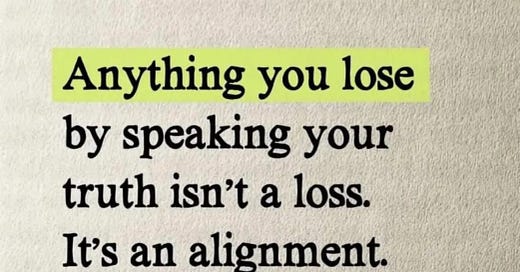TNWWY(ATNW) exists to advocate for the recognition and full access to the original wholeness that is our birthright, no matter what we have faced. This space is here to deconstruct everything that stands in the way.
I told the truth again. Over and over again, I am brought to a moment in which I’m called to act on a truth rising within—and I’m always terrified. I don’t want to lose people. I don’t want to be misunderstood. I don’t want to be alone.
But I’ve learned this much: the fear of telling the truth is never as destructive as the cost of withholding it.
The AA motto—To Thine Own Self Be True—is not a tagline. It’s the heartbeat of the 12 Steps, the Traditions, and the Concepts. It’s not always evident on the surface, but the principles embedded in the 12 Steps are designed to bring a person home to themselves. Not to some idealized version of self-improvement, but to the original self. The essential self. The one that’s always been there, waiting.
The paradox—losing the self to find it—is hard to grasp without total catastrophe. The alcoholic, the addict—desperate enough to reach for a rope from the depths of drowning—is led toward alignment with their true self, and away from the false.
But this truth doesn’t just apply to addiction. Anyone on the path of awakening—of healing, recovery, or authenticity—will eventually face that same turning point. The moment when the mask won’t hold. When the pretending stops. When the self you've been performing no longer feels livable.
That’s when the process begins—the work of peeling away everything that isn’t yours: the voices you inherited, the roles you performed, the safety you negotiated through silence, the conditioning you weren’t even aware of.
And what’s left, when all of that falls away, is your true self. But the true self is not an object we left behind somewhere. It needs nurturing, nourishing, and the hard work and synergy of both light and dark in order to come into being—it’s a becoming. And that becoming arises through the falling away of everything that is not it.
But here’s what they don’t tell you: that essence—like a seed newly cracked—doesn’t let you go back. It won’t let you abandon it to make others comfortable. It won’t stay silent to keep the peace.
Hardest of all, speaking your truth doesn’t guarantee it will be heard—or welcomed.
Sometimes when you speak clearly, even gently, the other person can’t receive it. They hear your truth as an attack. They experience your clarity as criticism. And instead of staying present, they shut down—or shut you out.
It’s one of the most painful things: to bring your truth forward with care, and be met with silence, dismissal, or severance. But even then, the truth still matters. The practice still holds.
Because truth is not measured by how it’s received. It’s measured by whether or not it’s yours.
I’ve been on the receiving end of someone else’s so-called “truth,” and I could feel it wasn’t coming from spirit. It felt like a projection. Like ego. And I’ve also spoken my truth with as much care and clarity as I could, only to be met with silence or severance. It’s tricky terrain. And I’ve been on both sides of it. I’ve spoken from ego too—when I was scared, defensive, or needed to be right. Sometimes I didn’t know until afterward. That’s part of the learning. The difference is, I keep watching. I keep listening. I’m willing to be shown when I’ve missed it. I don’t know how else to live except to name what I can feel in my bones. I know when something’s off. I know when my integrity is on the line. And even when it costs me something—and it so often does—I’ve learned I have to address it.
The thing about speaking your truth is that it’s not about asking the other person to change. It’s not about getting an explanation or hoping they’ll adjust to accommodate what you’ve named. It’s about alignment. You speak the truth because you have to—because not speaking it would cost you your integrity. And there is a real risk. Once the truth is spoken, the relationship may not survive it.
Of course, I don’t always get it right. None of us does. This isn’t about perfect truth-telling—it’s a practice. And I’m still learning. Sometimes, when something bothers me, the most loving thing I can do is pause. To wait. To practice restraint until I’m clear. That’s not silence out of fear—it’s discernment. Because when a situation is challenging my ability to function inside it, there’s pressure to act. To respond. To fix. But not everything that rises needs to be spoken right away. Some things need space. Reflection. Clarity. And that’s hard, but necessary. Especially if what we’re aiming for is real alignment, instead of instant relief.
I’ve been thinking about all of this in light of Glennon Doyle’s decision to leave Substack. I don’t know all the behind-the-scenes details, and I don’t need to. What I saw was a woman making a realignment move. A soul decision. More context here. And here. And it reminded me: the world of the spirit doesn’t always explain itself. It simply knows when it’s time to go.
This act of staying true teaches me where I stand. And it puts me back where I belong.
“This above all: to thine own self be true,
And it must follow, as the night the day,
Thou canst not then be false to any man.”
— William Shakespeare, Hamlet
I’d love to hear from you.
Truth bomb:
One Thing
How do I know the difference between intuition and ego?
I call my ego OGRE. It’s definitely not my friend. It wants to kill me and thinks it can somehow keep living.
It doesn’t ask questions. It makes demands. It talks fast. It reacts fast. It always wants me to act right now. Why? Because it hates uncertainty and wants instant relief from discomfort, even if the action it pushes me toward is out of alignment. It’s convinced it knows the answer, usually by focusing on where someone else is in the wrong. It never stops to wonder if it’s the one in the wrong. “There’s nothing wrong with me (and there never was)” doesn’t mean I can’t be wrong—or cause harm. When I’m out of alignment with my true nature, I make mistakes. That’s the practice: alignment, integrity, learning to act in accordance with who and what I was made to be…everything falls together.
Intuition is quiet and without conflict. Intuition doesn’t come with turmoil. If I’m disturbed, in doubt, in the midst of a brainstorm, or in fear - that’s a sign to wait. Inner conflict is like the oil light on the dashboard.
So I’ve learned to pause and go inward. My intuition is quiet and calm. The definition of serenity. It takes a lot of practice to recognize the voice of intuition. Most of us weren’t taught to trust our deeper selves. We’re full of self-doubt. So this is tricky—learning the difference. I don’t get it perfectly. I make mistakes. That’s how I learn.
I keep practicing the pause because it’s the key to learning. It took me forever to realize that the pause is how I find my intuitive voice. Feeling urgency doesn’t mean there is urgency. I had to learn that discernment requires restraint. I’ve always been impulsive and wild. For those of us with neurodivergence, like ADHD, ADD, or AuDHD, for example, this can be super difficult. But it’s so worth it.
Next time you feel urgency—pause.
Don’t fix. Don’t reply. Don’t explain.
Just pause.
Feel your feet.
Breathe.
Wait for the turmoil to pass.
Listen for the still, small voice.
It will be calm and quiet.
And if you’re put on the spot, you can say, “Let me get back to you.”
On Repeat:
If you want a soundtrack for this reflection, listen to Spirit in the Wind by Wayne Thompson—my husband and creative partner. This one came from the same place this essay did. It’s what alignment sounds like to me.
Shout Out
Love ’s response to this Note (my first viral note ever! gahhhh), so I had to check out her Substack. She had me at “pie and okra.” Kris writes, “I'm a 71-year-old homeless woman who lives in a cargo van. It's been my shelter for almost six years. Having a vehicle allows me to volunteer with several disaster relief organizations. It is critical for me to remain active and useful.” Now I’m a subscriber, and you should be too!
Thank you for telling other readers about TNWWY and for supporting my work.
Your financial backing allows me to spend time writing, advocating, hosting livestream conversations with colleagues, authors, and fellow survivors—livestreams like the one with Shavaun Scott, psychotherapist and author of Nightbird: A Memoir—and amplifying the voices of others in recovery, like ESH: From Rock Bottom to Badass: Five No B-S Lessons on How to Recover (From Anything).
This is uncovery.
From anything: addiction, religious trauma, spiritual abuse, domestic violence, family scapegoating, perfectionism, and the many ways disconnection and harm leave their mark.
It makes it possible for me to keep writing and creating for this community.
TNWWY exists to advocate for the recognition and full access to the original wholeness that is our birthright, no matter what we have faced. I first coined the phrase “There’s Nothing Wrong With You (And There Never Was),” to name the truth of our untouchable wholeness—a truth at the heart of everything I create here.
This space is here to deconstruct everything that stands in the way.
Telling the truth has a cost.
If the writing adds something real to your life—inspiration, clarity, a sense of not being alone—consider taking a turn and becoming a paid subscriber.
It’s the only way this can keep going.
If you’re into imperfect healing, questionable decisions, and laughing at the whole beautiful mess, you’re in the right place.













I love this! Thank you for sharing so clearly and honestly.
Two things that stand out, EGO (edging GOD out) and patience to let Go and let God). He doesn't need our help and we need to have faith in him. Patience is a strategy, and a good one. Especially when there isn't a clear choice in our heart.
Bless you, and keep on sharing your truth, love, and kindness!
Learn IT, Teach IT, Live IT. Make the world a better place!
These words came at the perfect time. Thank you! Eloquently and perfectly described. Absolutely agree.